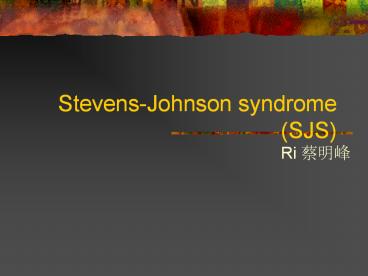Stevens-Johnson syndrome (SJS) - PowerPoint PPT Presentation
1 / 27
Title:
Stevens-Johnson syndrome (SJS)
Description:
Stevens-Johnson syndrome. severe expression of erythema multiforme ... cat-scratch fever (Bartonella henselae) mycoplasma. lymphogranuloma venereum. Histoplasmosis ... – PowerPoint PPT presentation
Number of Views:6760
Avg rating:5.0/5.0
Title: Stevens-Johnson syndrome (SJS)
1
Stevens-Johnson syndrome (SJS)
- Ri ???
2
Stevens-Johnson syndrome
- severe expression of erythema multiforme
- involves the skin and the mucous membranes
- oral, nasal, eye, vaginal, urethral, GI, and
lower respiratory tract mucous membranes - potential for severe morbidity and even death.
3
Stevens-Johnson syndrome
- Etiologic categories
- Infection
- Drug-induced
- Malignancy-related
- Collagen vascular disease
- Idiopathic
- 25-50 of cases
4
Stevens-Johnson syndrome
- Adults and the elderly
- Drugs and malignancies induced are most often
- Childs
- Related more often due to infections
5
Stevens-Johnson syndrome
- Early spring and winter
- Male-to-female ratio is 21
- Caucasian predominance has been reported
- Mortality rate 3-15 (or 30)
- second to fourth decade
- have been reported as young as 3 months
6
Stevens-Johnson syndrome
- Individuals appear to be more susceptible to
developing SJS - HLA-Bw44
- A part of HLA-B12
- HLA-DQB10601
7
Stevens-Johnson syndrome
- Typical symptoms are as follows
- Cough productive of a thick purulent sputum
- Headache
- Malaise
- Arthralgia
8
Stevens-Johnson syndrome
- The following signs may be noted on exam
- Fever
- Epistaxis
- Tachycardia, hypotension
- Conjunctivitis, corneal ulcerations
- Erosive vulvovaginitis or balanitis
- Altered level of consciousness, Seizures, coma
9
- Ocular symptoms
- Red eye
- Tearing
- Dry eye
- Pain
- Itching
- Foreign body sensation
- Decreased vision
- Burn sensation
- Photophobia
- Diplopia
10
History
- Typically begins with a nonspecific upper
respiratory tract infection - 1 to 14 days
- fever, sore throat, chills, headache, vomiting,
diarrhea and malaise may be present
11
History
- Mucocutaneous lesions develop abruptly
- last 2-4 weeks.
- typically are nonpruritic
- may lead to mucosal scarring and loss of function
of the involved organ system
12
History
- Esophagus involvement
- Esophageal strictures
- Tracheobronchial mucosa shedding
- Respiratory failure
- Ocular sequelae
- Corneal ulceration
- Anterior uveitis
- Keratitis or panophthalmitis (3-10?blindness)
- Vaginal stenosis and penile scarring
- Renal complications (rare)
13
History
- The rash can begin as macules that develop into
papules, vesicles, bullae, urticarial plaques, or
confluent erythema. - The center of these lesions may be vesicular,
purpuric, or necrotic. - The typical lesion has the appearance of a
target. - The target lesion exhibits central necrosis
surrounded by a rim of perivenular inflammation
14
- Mucosal involvement may include erythema, edema,
sloughing, blistering, ulceration, and necrosis.
15
History
- Although lesions may occur anywhere, but the rash
may be confined to any one area of the body - most often the trunk.
- Lesions may become bullous and later rupture,
leaving denuded skin. - The skin becomes susceptible to secondary
infection - Fever or localized worsening
- Fever occur in up to 85 of cases
16
History
- Recurrences may occur if the responsible agent is
not eliminated or reexposed
17
- Drug etiologies include
- Penicillins
- Sulfas
- Phenytoin (and related anticonvulsants)
- Carbamazepine
- Barbiturates
- valdecoxib (COX-2 inhibitor)
18
- Penicillin, sulfas, or phenytoin, had previously
been prescribed to more than 2/3 of all patients
with SJS.
19
- Hypersensitivity reaction to drugs has been
suggested that probably both - Immune hypersensitivity reactions
- Mediated by toxic intermediates
20
- Infectious diseases have been reported
- herpes simplex virus (HSV)
- Influenza
- Mumps
- cat-scratch fever (Bartonella henselae)
- mycoplasma
- lymphogranuloma venereum
- Histoplasmosis
- cholera
- In children, Epstein-Barr virus and enteroviruses
have been identified
21
- Elevated in serum level
- TNF-a
- IL-2 receptor
- IL-6
- CRP
- However, none of these serologic tests is used
routinely in diagnosing SJS
22
- CBC may reveal
- Normal WBC count or a nonspecific leukocytosis
- A severely elevated WBC count indicates a
superimposed bacterial infection
23
- Typical histopathologic findings
- Initially, dermal inflammatory cell infiltrate
- superficial and mostly perivascular
- Migration of lymphocytes along the
dermoepidermal junction - Keratinocytes undergo apoptosis
- Full-thickness necrosis of epidermis
- blister formation
24
- Conjunctival biopsy
- active ocular disease
- subepithelial plasma cells lymphocyte
infiltration - Lymphocytes are perivascular
- The predominant is the helper T cell
25
- Skin lesions are treated as thermal burns
- Attention to
- airway and hemodynamic stability
- fluid status, wound/burn care
- Electrolyte correction
- pain control
- Treatment of SJS is primarily supportive and
symptomatic
26
- Offending drugs must be stopped
- Underlying diseases and secondary infections must
be identified and treated - Oral lesions
- mouthwashes
- Topical anesthetics
- Useful in reducing pain
- Allowing the patient to take in fluids
- Areas of denuded skin
- Covered with compresses of saline
27
- The systemic steroids use is controversial
- Useful in high doses early in the reaction
- But morbidity and mortality actually may increase
in association with steroid use - Because of increasing secondary infection rate
- Some authors believe that they are contraindicated

